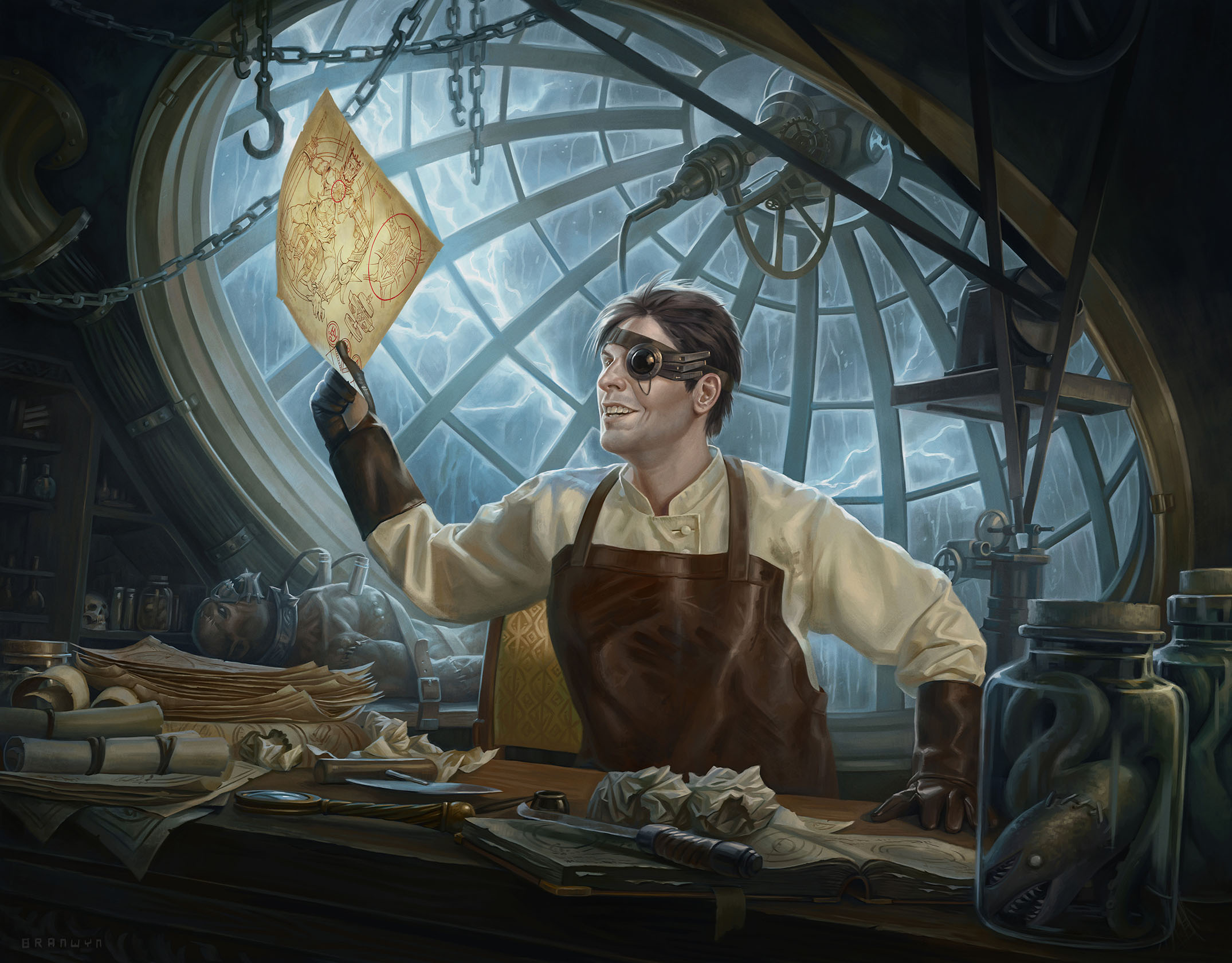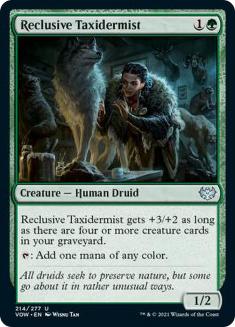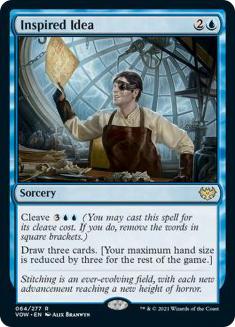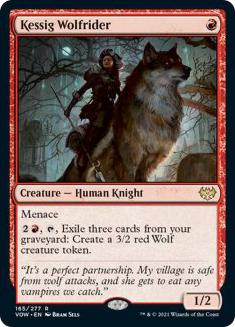Innistrad: Crimson Vow is just about to drop, and while I haven’t felt anything resembling the unbridled rush of creativity that flowed out of rotation, I still have found some decks that I look forward to tuning in the coming weeks. Honestly though, my approach to this format is pretty simple. Nothing has shaken my steadfast belief that Alrund’s Epiphany will remain the key card in Standard for as long as it’s legal. Pure midrange still seems like a fool’s errand.
This means that I’m only interested in three baseline strategies:
- The fastest, most consistent aggro deck
- A slightly less fast but more disruptive aggro deck
- A deck with access to countermagic
While this is restrictive, it’s still enough space to do some interesting deckbuilding. These five decks I’ve got for you today all fall into these buckets, and all are bringing something new to the table. Let’s talk about what each one is doing, and why I think they might be better than preexisting options in their same lane.
1. Mono-Red Aggro
Creatures (24)
- 4 Hall Monitor
- 4 Moonveil Regent
- 2 Bloodthirsty Adversary
- 4 Falkenrath Pit Fighter
- 4 Reckless Stormseeker
- 2 Kessig Wolfrider
- 4 Voltaic Visionary
Planeswalkers (2)
Lands (8)
Spells (26)

Mono-Red Aggro is looking to occupy the same space as the existing Mono-White Aggro❄ and Mono-Green Aggro❄ decks. Just get your opponent dead before expensive sorceries have time to matter. Four new cards make the cut in our maindeck. Kessig Wolfrider looks to round out our suite of one-drops, and I expect it will be hot medium. That’s what we get in red for one-mana plays these days, and I’m just happy to have an option that allows us to get to ten one-drops, since our early clock is so important.
Voltaic Visionary is our newest two-mana play, and I’m actually excited about this card. It basically gets three opportunities to be relevant. An early 3/1 on an empty battlefield will push plenty of damage, but at the moment it gets out-scaled you can tap it and cash it in for another card. Then you get a second opportunity at a relevant body when it becomes a 4/3. None of this feels super-far above rate, but I suspect it’s just going to be nice glue in the archetype.
Chandra, Dressed to Kill is facially at its best in Mono-Red, but I think it’s also the correct home from a strategy standpoint. Plenty of one-mana plays mean that Chandra has an opportunity for immediate impact, and the small amount of reach she provides is something Mono-Red is unexpectedly missing at this moment. I still expect she’s only at her best against slower decks, but hopefully she can still earn a maindeck spot against aggressive opponents.
Our final card is only a one-of, but I think it’s an important one. A limited Time Walk effect has long been a thing for Mono-Red decks, and at a moment where if you pass the turn to your opponent you may not get another one, Alchemist’s Gambit is more important than ever. I don’t think we’ll ever pay the cleave cost, but the addition of Riverglide Pathway could garner some bluff equity in the early days of the format anyway. Besides, I had already made up my mind to play a non-snow manabase, since early untapped red and Spikefield Hazard and Shatterskull Smashing are just too important in the current format.
Mono-Red Aggro has a unique approach for an aggressive deck in this format. It’s got the respectable clock, but it also finds some reach that the other aggro decks are presently missing. With the control decks expecting a lot of safety to use their life total as a resource, Mono-Red just might be the way forward.
2. Selesnya Humans
Creatures (32)
- 4 Thalia, Guardian of Thraben
- 4 Elite Spellbinder
- 4 Brutal Cathar
- 4 Intrepid Adversary
- 3 Katilda, Dawnhart Prime
- 4 Hamlet Vanguard
- 4 Reclusive Taxidermist
- 1 Ollenbock Escort
- 4 Hopeful Initiate
Lands (12)
Spells (16)
- 6 Forest
- 6 Plains
- 4 Ranger Class

Five new cards enter the maindeck mix in this take on Selesnya Humans, which falls soundly in the category of disruptive aggro deck. Of course, our disruption comes chiefly from our white cards, so there’s got to be a good reason to abandon the proven Mono-White Aggro❄ lists for this take.
The reason is scaling. While Mono-White lists are somewhat limited by their cards and the tops of their decks, Selesnya Humans can just go off, in large part due to Katilda, Dawnhart Prime. This should translate to an edge against other aggressive decks in the format if we can avoid being run over. Thankfully, we’ve got some good sizing and acceleration to help with that task.
Katilda has been with us for a while now, but it’s picked up a backup mana producer to increase consistency.
I know a lot about early 2000s Magic has changed, but I have to believe a Werebear is still good enough for Standard, especially when it gets a relevant creature type. This card allows us to play through our glut at the three-drop slot, and we’ve got no shortage of mana sinks ready to use Reclusive Taxidermist — assuming it’s not just smashing in for four.
Thalia, Guardian of Thraben is probably the headline addition here. Despite what seemed like some pretty heavy naysaying from me over on Twitter, I do believe the card is great. Not “beat Izzet Epiphany on its own” great, but great nonetheless. Elite Spellbinder is also doing the disruption thing, and it’ll be a real slog for Izzet decks to work through. They would though. They’ve got sweepers and removal, and if you give them too much time, they will find a way.
This is why Hopeful Initiate and Hamlet Vanguard are so critical. A one-drop that both scales and checks some big opposing threats, Hopeful Initiate feels like a sleeper out of the gate. However, it’s not difficult to subject this card to some training, and you don’t need to go all-in on a counter theme to be able to claim consistent outs to opposing Esika’s Chariots. The card does a lot out of the one-mana slot, and makes previous options look laughable.
Meanwhile, Hamlet Vanguard has keyword “big,” and I think that’s a good fit for this format. It’s hard to kill a five-toughness creature, and most decks will rely on something like Fading Hope as their out. Ward 2 means we don’t give up a mana advantage when trading with that card, and in some scenarios the ward might even buy us an extra attack. If you start talking 7/7 Hamlet Vanguards, then things get downright problematic for opponents. Sure, it’s pretty awful on an empty battlefield. The full set of Ranger Class should make that a rarity, and we’ve even got a one-of Ollenbock Escort to buy a little extra protection.
I admit, this deck has some cards that no one seems excited about. In cases like that, it’s always possible I’ve just got it wrong. But I think these new adds are exactly what Humans has been missing, and if it really can outscale opposing creature decks with its mana advantage, we might have something special on our hands.
3. Izzet Delver
Creatures (11)
Lands (8)
Spells (41)
- 1 Mountain
- 6 Island
- 4 Syncopate
- 2 Spikefield Hazard
- 2 Sea Gate Restoration
- 4 Shatterskull Smashing
- 2 Jwari Disruption
- 4 Expressive Iteration
- 4 Play with Fire
- 4 Consider
- 4 Fading Hope
- 4 Inspired Idea
Sideboard

We’re back looking at Izzet Delver lists again, after thoroughly hating on these decks for the entirety of the last format. Something big must have changed, right?
Finally, there’s a good reason to load your deck up with the cheap spells that Izzet Delver was previously demanding of you. Inspired Idea allows us to dump our hand full of one-drops in the first few turns and load back up with more disruption and threats at a laughably low cost. Again, Expressive Iteration already did some of this, but it really needed a friend.
Same for Delver of Secrets, who really missed another decent one-mana creature to get on the battlefield alongside it. Finally we have the answer in… Kessig Wolfrider?
Don’t laugh! Kessig Wolfrider actually does everything this Izzet Delver deck wants. It produces resources out of thin air and it does so at instant speed. 3/2 Wolves are great on the types of empty battlefields your deck is good at creating. And we even like having some sacrificial fodder for our Overcharged Amalgams. And wow is that card made for an archetype like this. Simultaneously one of our best threats and answers, it’s another reason Delver’s time might finally be here.
None of this works without disruption and alongside Overcharged Amalgam, Syncopate is finally the catch-all countermagic we’ve been waiting for. As an Izzet Delver deck, you really do need to be able to answer everything based on context. Sometimes you’re protecting creatures, sometimes you’re stopping threats. Cards like Negate and Disdainful Stroke having holes just isn’t acceptable when your margins are so thin.
We round out our new additions with the best card in the set, Stormcarved Coast. It’s not sexy, but consistent mana wins more games than anything else. Finally, I’ve got some Wash Away in the sideboard. This card has the acceptable floor of three-mana counterspell alongside its god mode of one-mana Alrund’s Epiphany counter. Epiphany is a big enough problem that I love some thing like this over Negate or even the flashier Test of Talents. You’ve got to use every drop of your mana to succeed as Izzet Delver, and Wash Away will help.
4. Azorius Spirits❄
Creatures (20)
- 4 Ascendant Spirit
- 4 Usher of the Fallen
- 2 Spectral Adversary
- 2 Overcharged Amalgam
- 4 Dorothea, Vengeful Victim
- 4 Fleeting Spirit
Lands (25)
Spells (15)

Izzet Delver isn’t the only way to build a disruptive tempo deck. Azorius Sprits❄ also found some nice tools, chief among them Geistlight Snare. We really want this card to do a Mana Leak impression in this strategy, so we’re playing a full eight of the best one-mana Spirits — Ascendant Spirit and Usher of the Fallen. We also benefit from early pressure due to our adoption of Dorothea, Vengeful Victim. This card is one of the best ways in the format to push damage, and having our opponents on the back foot means that we’re uniquely able to leverage the eight-plus damage that Dorothea routinely brings to the table at the low cost of a single card.
Dorothea is also underappreciated as a quasi-removal spell. As far as real removal goes, Circle of Confinement plays great with our Geistlight Snares, and if we get those down to a single mana, we really open up how aggressively we can spend mana on our own turn.
Fleeting Spirit seems like the right card in the two-mana slot to me. We should have cards to spare, and the threat of first strike is often as good as first strike itself. The rest of our new cards are “just” disruption, but disruption plus clock really is everything in this format. My big question marks here all revolve around the manabase. While I think this deck can get away with drawing a non-snow land like a Hengegate Pathway, I am worried about the impact of the tapped Glacial Floodplains on our curve-out plans.
5. Izzet Dollhouse
Creatures (11)
Lands (12)
Spells (37)

Probably my favorite of my new decks, Izzet Dollhouse has me itching for release day. The curve of Unexpected Windfall into a Dollhouse of Horrors not only deposits a creature into the bin and gives you enough mana for an activation, it even leaves a mana around to spare. This is a huge deal given that our chief reanimation targets are Lier, Disciple of the Drowned and Hullbreaker Horror. In Lier’s case we may only get to fire a Consider or Fading Hope from our graveyard, but Hullbreaker Horror has the potential to eat our opponent’s entire turn if they are foolish enough to try to cast a big spell.
Of course, against some players we’ll just want to use the ramp to seven mana to hard-cast a Hullbreaker Horror, and this is going to be a hard KO against many strategies. It not only outsizes Mono-Green, it also allows you to answer their entire battlefield once you untap with it. Against Izzet Epiphany, it allows you to keep up countermagic on your turn and cast an uncounterable threat on their turn that they almost certainly can only answer with Fading Hope. This card is destined to be an Izzet mirror-breaker, and no deck is better set up to leverage it than Izzet Dollhouse.
We’ve also got Wandering Mind in the deck, which is both a fantastic setup card and a more than fine reanimation target in the late-game. Six cards into your library is so deep, and this has got to be the most generous version of this effect we’ve seen in ages. And we’ve still got the typical Divide by Zero / Lier nonsense that I’ve loved since Day 1 of its appearance in Standard.
There’s a lot to be sorted out here with the specifics. Am I supposed to play more sweepers main and just give up on spot removal, or is Hullbreaker Horror enough of a catch-up mechanism? Is there some way to fuse this plan with Izzet Epiphany? I look forward to working this stuff out, but in the meantime I’m excited to see what the raw power of Dollhouse of Horrors can do.
As you can see, Standard has ideas worth exploring, even if the moves feel a little choreographed. Of course, it’s possible that any deck could come along and flip the entire format on its ear, changing the rules of engagement overnight. The unknown is what makes a new set’s release exciting, and Innistrad: Crimson Vow has just enough mystery to keep me invested.





